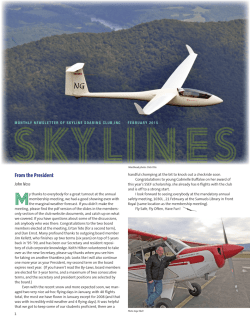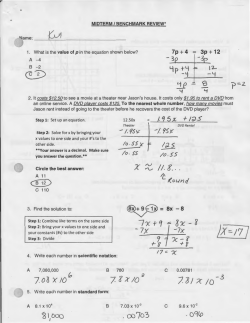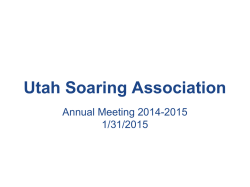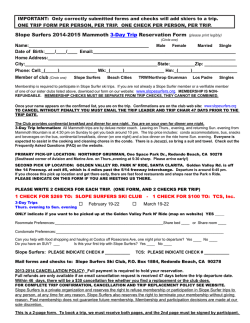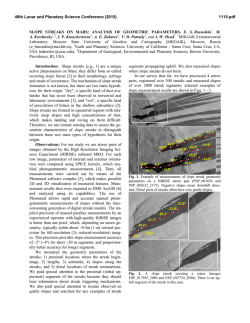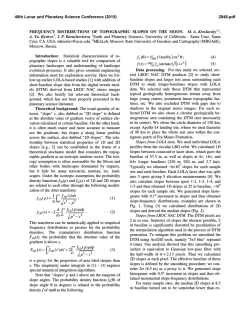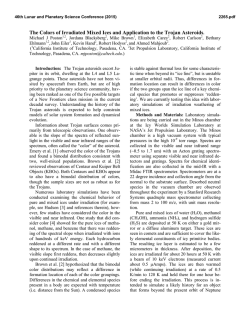
this linked PDF file
SoaringDigest Radi February 2015 C ntr lled Vol. 32, No. 02 CONTENTS February 2015 4 Vol. 32, No. 02 Front cover: Kevin Farr's Constellation Super G is launched by Malcolm Riley and Richard Chase. Kevin's model was on the front cover of the RCSD August 2012 issue, and the construction article appeared in the October 2012 issue. Photo by Steve Meusel Canon EOS 60D, ISO 100, 1/800 sec., f5.6 Slovenian Slope Soaring Three picturesque slopes in Slovenia are described by Uroš Šoštarič, translation by Gorazd Pisanec. Photos by Uroš and Bernarda Šoštarič. 10 Walk-around Scheibe SF 27A Zugvögel V, N5602D Scheibe Flugzeugbau GmbH, Ser. No. 6074, photographed by Mark Nankivil. Southern California F3J 22 In California for a business trip, Brian Ford took advantage of the situation and visited an "F3J with winches" event at Perris Field. (Not having a camera with him, Brian took all of the photos with his ’phone.) Balsa, carbon, transparent covering 29 Photo by Bill Kuhlman Back cover: Kevin Farr's Constellation Super G is launched at the Hermanus 2013 slope event in South Africa. Photo by Noel Cochius Panasonic DMC-FZ18, ISO 125, 1/500 sec., f3.2 2 R/C Soaring Digest R/C Soaring Digest February 2015 Volume 32 Number 02 Managing Editors, Publishers Bill & Bunny (B2) Kuhlman Contact [email protected] [email protected] http://www.rcsoaringdigest.com Yahoo! group: RCSoaringDigest FaceBook: https://www.facebook.com/RCSoaringDigest R/C Soaring Digest (RCSD) is a reader-written monthly publication for the R/C sailplane enthusiast and has been published since January 1984. It is dedicated to sharing technical and educational information. All material contributed must be original and not infringe upon the copyrights of others. It is the policy of RCSD to provide accurate information. Please let us know of any error that significantly affects the meaning of a story. Because we encourage new ideas, the content of each article is the opinion of the author and may not necessarily reflect those of RCSD. We encourage anyone who wishes to obtain additional information to contact the author. ——— Copyright © 2015 R/C Soaring Digest Published by B2Streamlines http://www.b2streamlines.com P.O. Box 975, Olalla WA 98359 All rights reserved ——— RC Soaring Digest is published using Adobe InDesign CS6 February 2015 In the Air Just three articles this month, but all are impressive. From Slovenia, Uroš Šoštarič and Gorazd Pisanec provide RCSD readers with an overview of three slope soaring sites in their country. These are incredibly beautiful sites with good lift and greater than reasonable landing areas. Mark Nankivil, photographer extraordinaire, presents the Scheibe SF 27A Zugvögel V. This is an interesting design with good lines and, being Standard Class (15m wing span), can be easily modelled in 1:4 or 1:3 scale. From a modelling standpoint, the fuselage construction is rather unique in that the forward fuselage back to the wing trailing edge is an exterior fiberglass shell mounted to the interior steel framework. Additionally, the tow hook is mounted on the bottom of the fuselage just in front of the main wheel, not in the nose. Brian Ford is a prior contributor to RCSD and usually provides materials describing activities in Australia. So when Brian gave a positive response to our request for his perspective on an "F3J with winches" event in California we were pretty excited. Brian compares this event with similar and related events in Australia and the included pictures are quite good, despite having to use his ’phone for all of the photos. Submissions for future issues of RCSD are always welcome and appreciated. If you have any questions about the submission process - text formats, photo size, etc. - please drop an email to us at <[email protected]>. Time to build another sailplane! 3 Slovenian Slope Sites Article by Uroš Šoštarič Translation by Gorazd Pisanec, [email protected] Where has man made the first flights, or rather first jumps with the beginnings of sailplanes? On the nearby hills and smaller slopes, which later became greater, due to the development of sailplanes. Modellers have followed these examples and began flying their first models on a small hill themselves which resulted in model slope soaring. Slovenia is an Alpine country on the sunny side of the Alps, where the Alps are ending and turning into the highlands. Most of Slovenia is mountainous and hilly and, as such, offers excellent conditions for slope soaring. The Julian Alps with their cliffs, deep valleys and wide vistas offer true alpine soaring with a full dose of adrenalin. Weather and thermal conditions to fly in the Alps are very complex and highly variable as are the local flying terrains. Take-offs and landings are complex and require 4 a good deal of experience and correct assessment of the current situation. When the Alps turn into the highlands, it all becomes a bit softer and not as full of adrenaline; it is more flying-friendly on one hand but on the other, the surroundings are less astonishing and offer different charms. In principle, each and every slope has its qualities that allow us to fly or soar under certain conditions. These qualities need to be accepted, observed and, if necessary, changed according to new findings. Slopes can be used as thermal, windy, or a combination of both. In this article I will present three most famous and also most visited slopes in Slovenia, each one with its own characteristics, requirements and surroundings. In Slovenia, there are over thirty slopes that are used by modellers more or less regularly. They are located in the Julian Alps, the Karavanke and pass through the hilly areas into the Pannonian region, where it is also possible to fly on a smaller hill. Let me begin with the highest and most majestic which is Mangart. Mangart is the fourth highest mountain in the Julian Alps and is located in the northwest of our country, on the border with Italy. There is a beautiful Alpine road leading to the ridge of the mountain at 2050 meters above sea level. The road was built by the Italian builders during the interwar period and is today very well preserved and nicely settled as the highest road in Slovenia. A spot where it is possible to fly models is located on the southern slope of the valley Koritnica at a height of 1930 metres above sea level. In fact, it is a small ridge about 50 metres away from the north side of the Mangart road and on the south side of the cliffs of Mangart R/C Soaring Digest where the valley is more than 1000 meters away. From the small parking lot by the road we arrive to the saddle in a fiveminute walk. Flying season is limited according to conditions of the road and is usually open from mid-June till late September because of the high altitude. The saddle itself offers small area of landing spot covered with soft grass. On the right hand side is the peak called Mali vrh at 1991 meters above sea level, and on the left hand side raises the south wall of Mangart. The distance between these two is around 300 metres which makes the flying site even more appealing and adrenaline-full. Take-offs are not problematic due to steep ridge. The ridge lift is always present here. The best soaring conditions appear when there is no wind and the ridge lift is generated only by thermals. With these conditions we have the best soaring in strong thermals without turbulences throughout the day. A strong wind usually starts to blow in the late afternoon which makes landing a bit more difficult. These conditions are ideal for cumulus and cumulonimbus clouds which are very common in the Alps. They come very fast and quickly evolve in thunderstorms or light showers. But sometimes they only cover the saddle and prevent modellers from flying. Mangart Upper: Saddle area appropriate for slope soaring in Mangart. Behind is the highest road in Slovenia (2050 metres above sea level). Start of DG1000 on an ideal August day. Photo by Bernarda Šoštarič Lower: A view from Mangart saddle towards Jalovec Mountain above Koritnica valley. Waiting for good soaring conditions. Photo: Bernarda Šoštarič February 2015 5 Landings are quite difficult for larger models because the landing area is in the lee side. The area on the top is grassy but gets irregular with bumps and stones towards the road. Sailplanes with butterfly can easily land on the top of the saddle or in the lee side. A mountain cabin is located very close by and offers food, drinks and accommodation. Beside slope soaring one can take advantage of real Alpine hiking and experience adrenaline sports which are famous in the Bovec area. Julian Alps from NW to SW turn into highlands with peaks from 1000 to 1600 meters above sea level. These highlands have lots of steep slopes which are mostly covered with forests. Even so, great slope sites can be found. One of them is ridge Jamnik above the village Kropa near Lake Bled. The ridge is 500 metres long and lies 836 metres above sea level. It is part of the Natura 2000 national park. Because of its diversity and integrity, the area is protected. It offers great panoramic view of Gorenjska region. At the end of the ridge lays the church of St. Primus and Felician which dates back to the 14th century. The scenery with the church is magnificent. Slope site Jamnik with its excellent soaring conditions was discovered by modellers 40 years ago. It is accessible by car taking the road Kropa – Dražgoše. Just before the village Jamnik, there is a parking lot where we continue on foot along the ridge. The ridge is very narrow with steep grassy area which runs into valley on the south side. In this hollow, strong thermals are made and this is why Jamnik is an excellent thermal slope and not as Jamnik Upper: Jamnik slope site with its steep southern site, medieval church and modellers’ area with the weather station. Photo by Uroš Šoštarič Lower: Late summer soaring in Jamnik with excellent thermals. Photo by Bernarda Šoštarič 6 R/C Soaring Digest appropriate for the slope lift generated by wind. Jamnik is also very famous for its evening thermals when the accumulated heat from the forest starts to rise. Since the south ridge is very steep and the north is filled with forests almost to the top, there is little space for landing area. At the top of the ridge there is a small country road with a small flat area. Landing is possible on the south part of the ridge with models up to 4.5 metres of wingspan. Air brakes are necessary. Alpski modelarki klub (R/C hobby club) from Kranj has arranged special area for modellers with a picnic table, information table and weather station, which sends information about wind direction, speed and temperature via mobile phone. A modeller can easily decide if the weather is suitable for soaring and which model to take. The flying season is open all year round. In winter the snow on the south slope is quickly melted by the sun and then winter thermals appear. They create a couple of hours’ thermals. Highlands towards SW turn into Dinaric Karts region. These areas are called Notranjska and Kras (Karst) and offer some of the greatest soaring locations with some well-known tourist attractions like Postojna and Skocjan caves. This land is also very famous for its prosciutto which means that it is very windy. Vremščica is the most famous slope site in this area above the town Divača and is February 2015 Vremščica: Modellers from Italy, Austria and Slovenia meet on Vremščica slope. Photo by Uroš Murkovič located near highway Ljubljana – Koper. Vremščica is a stretched hill at 1027 metres above sea level. It has wide flat meadows on the south side interrupted with pine forest. Vremščica is located in the Karts region where north wind Burja is very strong. At the same time, the north wind is not used for slope soaring simply because there are no appropriate slopes facing north. Slope site is located 870 meters above sea level and is facing south west where large meadows lay. Pine forest and stones are located at the bottom of the hill. We leave the car by the country road on the north side and continue on foot. The slope is reached within 5 minutes. At the top of the slope we have great panoramic view of the Karts region and Trieste bay. When the sky is clear we can 7 Vremščica: Vremščica soaring with landing area on the bottom right hand side. Safe landings are enabled even in the strongest winds with models of all sizes. Photo by Bernarda Šoštarič 8 R/C Soaring Digest see all the way from Venice, Italy to Julian Alps and Dolomites. The slope site offers flying for the biggest models. There are several ways to launch the model. The slope’s lift is generated by thermals, SW wind or by combination of both. Landings are not problematic thanks to large, flat and grassy meadows behind. Vremščica slope generates best lift when the SW wind is blowing. The wind reaches speed from 15 – 20m/s which generates constant and laminar lift. These conditions appear before the arrival of bad weather and storms from SW. On a beautiful sunny day slope lift is increased by thermals. Different wind directions don’t create suitable lift conditions. Flying season is open all year round. In winter, flying is not appropriate when there is a lot of snow or when cold wind is blowing. Modellers from Slovenia, Italy and Austria meet on the slope and enjoy slope soaring throughout the day till late evening on stable thermals watching the sunset above Trieste bay. Vremšiča offers superb soaring conditions for all types of sailplanes with excellent landing area and is one of the best I have experienced so far. Surroundings also offer wide options for family trips or visiting the Adriatic coast. We have now seen some of the famous slope sites in Slovenia. Of course there are a lot more sites in Slovenia. Perhaps in another article we will write more. With February 2015 Vremščica 1: Starting place on Vremščica slope with a view towards Trieste bay in May when soaring conditions are the best. Photo by Bernarda Šoštarič the rise of modern electric drives and other types of model flying, slope soaring has slowly faded. Hopefully, we can find a way to popularize it again together. You can get more information here <[email protected]>. Welcome to the sunny side of the Alps. 9 Walk-around Scheibe SF 27A Zugvögel V Ser. No. 6074, N5602D, owned by SF27 L.L.C. Mark Nankivil, [email protected] The SF-27 is a shoulder-wing, single seat Standard Class sailplane. It was designed to 1960s Standard Class competition rules requiring a span of no more than 15m and a fixed undercarriage. Built of fiberglass, wood and steel, its structure was conservative. At a time when many manufacturers were using fiberglass structurally in wings and fuselages, the SF-27 only used it to cover the forward fuselage. The wing of the SF-27 is built around a single beechwood boxspar. The wing ribs are spaced only 4 inches apart and heavy plywood skins cover 85% of the surface in order to help maintain the laminar profile. The inner section is covered with plywood from the leading edge to behind the spar, the rest with a mixture of plywood and fabric. Ailerons and Schempp-Hirth airbrakes are likewise plywood covered. The cantilever horizontal tail is an all-moving plywood and fabric covered surface set at the top of the fuselage, the fin is covered with plywood and the rudder with fabric. The fuselage is a welded steel structure covered, from nose to wing trailing edge, with a fiberglass shell. The wing root fairing is also fiberglass. Further aft the fuselage is fabric covered over wooden stringers. The cockpit, within the fiberglass shell, has a single piece Plexiglas canopy, the pilot sitting in a semi-reclined position. The SF-27 has a fixed single wheel main undercarriage, fitted with brakes, plus a small tailwheel. 10 Specifications Span Area Aspect ratio Airfoil Empty weight Payload Gross weight Wing loading Structure 15.0 m./ 49.2 ft 12.00 sq. m. / 129.2 sq.ft. 18.7 FX 61-184 root, FX 60-126 tip 205 kg. / 452 lb. 115 kg. / 254 lb. 320 kg. / 706 lb. 26.67 kg/m2. / 5.42 lb/ft2 steel-tube / f’glass & fabric fuselage wood / fabric wings and tail. Performance L/D max. Min. sink 34 at 80 kph / 43 kt / 50 mph 0.65 m/s / 2.14 fps / 1.27 kt at 69 kph / 37 kt / 43 mph _____________ Country of origin Manufacturer Designer No. made Germany Scheibe Flugzeugbau GmbH, Egon Scheibe ~120, more than 50 still flying R/C Soaring Digest Scheibe SF 27A / Loravia LCA 10 The Loravia LCA 10 Topaze is the French version of Scheibe SF 27A - Zugvögel V February 2015 11 12 R/C Soaring Digest February 2015 13 14 R/C Soaring Digest February 2015 15 16 R/C Soaring Digest February 2015 17 18 R/C Soaring Digest February 2015 19 20 R/C Soaring Digest February 2015 21 Southern California A visitor’s perspective of a competition in a foreign land F3J Brian Ford, [email protected] So, what was it like? It was a two day event, 8th and 9th November, and I went on the last day. This was F3J with winches, very similar to what we do here in Australia except they use braid on the bottom line and mono on the top line. It’s not run like the usual US style TD (thermal duration) events at all and a few newcomers needed convincing the FAI way of launching wouldn’t bite them. Field set-up was much like large Australian events with pits behind the launch lane, spots behind and cars (mostly) to the side. 22 Dust devils were around so they always had an eye out for them coming through the pits. Weather was around 30°C/86°F, sunny, clear, dry and dusty, although breezy at times. Wish I was there a few weeks earlier, the US F3B team selections were held at the same field. It’s really tough for our US R/C soaring brothers to find new flying sites and it takes a lot of work to keep one when they manage to get access. This one is a shared space amongst three flying groups. An R/C power club, a free flight club and the sailplane comps are flown there. To the north is Perris Airbase, to the west is Perris Valley airport, and large sky dive aircraft climb by circling around the model flying field. There seemed to be a constant stream of meat bombs tumbling earthwards. Pilots? There were a few of the top US pilots F3X pilots there, that’s B, J and F, names you have seen on RCGroups and World championship write-ups. I got to meet people I’d read about over the years - Larry Jolly, Tom Keisling, Robert Cavazos, Mike Lee, Warren Day (F3F guru). It was great to put a face to a name/username. R/C Soaring Digest February 2015 23 24 R/C Soaring Digest February 2015 25 This event was expertly organised at Perris Field by Tuan Le (FNNWizard on RCGroups) and CDed by Mike Lee. Age group was very much like here in Australia, early 30s to 60ish with some exceptions either side. As we have here, the pilots are from all walks of life. Most of the guys pretty much fly at least one comp a month somewhere in the area. They were all polite and friendly and the pit talk was very similar to what we have in Australia. Models at this event? Mainly Explorers, a few Pike Perfects/ Perfections and some Maxas, Supras, Aspires, and some other designs. There were some B models, too - Fosa Lift, Crossfires? Very few V-tails. The flying was not too savage with light lift around so pilots nearly always found some rising air somewhere during the flight and usually stuck with it once they found it. Most heats were 10 minutes, but in F3J you have 15 minute fly-offs to end the competition. That was a harder task. Go a very long way downwind or leave lift to find something closer? One model had the battery die mid-flight so that didn’t end well. There were a couple of out-landings, but the pilots nearly always got back from a long way downwind. 26 R/C Soaring Digest February 2015 27 Landings? The better guys were nailing 98 to 100s often and within 1 or 2 sec of end of working time. Remember, for J you need to fly the longest flight in the working time. So for a 10 minute working time a score of 9:57 and a 98 and better landing is your goal. The good pilots do this consistently. Remember, that includes the launch! Speaking of which, the technique I noted is a helper connects the model to the chute about 10m in front of the winch then walks backwards, and then in the last seconds before launch walks behind the winch corridor to build big tension. Another helper hits the pedal about 1 second before working time. The pilot concentrates solely on the model. This is different to how we launch in Australia for our thermal comps, but does replicate the F3J hand tow launch style reasonably closely. The common Australian thermal event is closer to the F3B duration task. Was it worth visiting? Absolutely it was, even though it needed a four hour round trip in LA traffic driving on the wrong side of the road, in the wrong side of the car, in an unfamiliar land to go see other people have fun. Flying would have been good, but you can still learn of lot of valuable things by watching. I’ve now been to events in New Zealand, England, Germany and the US. Sailplane pilots are the best! I felt very welcome at every place. Thanks, guys! 28 R/C Soaring Digest “Balsa, carbon, transparent covering” a photo by Bill Kuhlman. Konica Minolta Maxxum 7D, ISO 100, 1/125 sec., F10.0, 40mm February 2015 29
© Copyright 2025
